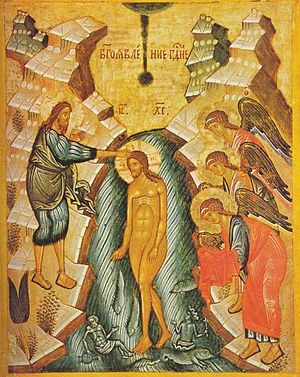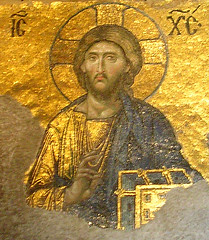Although the belief of Jesus having migrated to Kashmir had previously been researched in the literature of independent historians pre-dating the foundation of the movement[1], the Ahmadiyya Movement are presently the only religious organization to adopt these views as a characteristic of their faith.
Overview
According to the late 19th Century writings of Mirza Ghulam Ahmad, the founder of the Ahmadiyya movement, the theological basis of the Ahmadi belief is that Jesus was only “in a swoon”[2] when he was taken down from the cross. Mirza Ghulam Ahmad interpreted the phrase in Deuteronomy 21:31: kī qilelat Elohim taluy, “… for a hanged man is the curse of God”, as suggesting that “God would never allow one of His prophets to be brutally killed in such a degrading manner as crucifixion. Following his ordeal, Jesus was cured of his wounds with a special ointment known as the 'ointment of Jesus' (marham-i ʿIsā).”[3].After his Resurrection from the tomb, Jesus had fled Palestine to avoid recapture and journeyed towards India. Jesus later settled in Kashmir where he died a natural death of old age[2][3], and was laid to rest in Srinagar, Kashmir. The prophet Yuz Asaf said to be entombed there (at what is now known as the Roza Bal) is said to be that of Jesus of Nazareth.[4]
According to ancient manuscripts and Kashmiri tradition, Yuz Asaf is said to have been a Prophet who had miraculous healing powers and had travelled from Palestine during the 1st century.[5]
According to the Encyclopedia of Islam, this aspect of Ahmadi belief is one of three primary characteristics that distinguish Ahmadi teachings from general Islamic ones, and that it has provoked a fatwa against the movement.
| Ahmadiyya Islam |
Mirza Ghulam Ahmad |
| Prophecies · Claims · Writings |
Views & Belief |
| Five Pillars of Islam · Qur'an · Sunnah · Hadith · Jesus · Prophethood · Jihad |
Branches |
| Ahmadiyya Muslim Community · Lahore Ahmadiyya Movement |
Literature |
| Barahin-e-Ahmadiyya · The Philosophy of the Teachings of Islam · Jesus in India · Noor-ul-Haq · Victory of Islam · Commentary on Surah Al-Fateha · Malfoozat · Tafseer-e-Kabeer · |
Buildings and Structures |
| White Minaret · Mubarak Mosque |
![Reblog this post [with Zemanta]](http://img.zemanta.com/reblog_e.png?x-id=67c14f6a-a2e2-4aca-8860-0abb8d3f2421)

![Reblog this post [with Zemanta]](http://img.zemanta.com/reblog_e.png?x-id=32c6ceb5-3fee-463a-9e28-2724587be841)

![Reblog this post [with Zemanta]](http://img.zemanta.com/reblog_e.png?x-id=b17b0d05-9b18-4688-9b84-5f4eeb4739ea)






